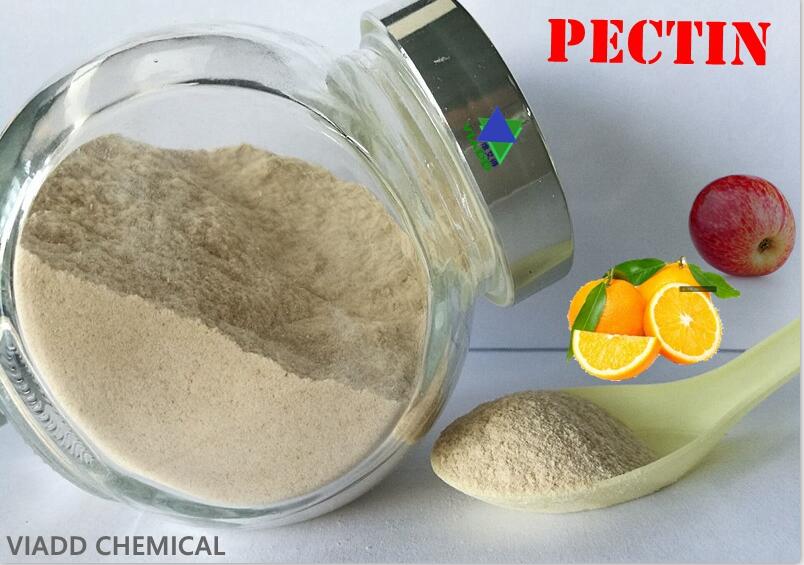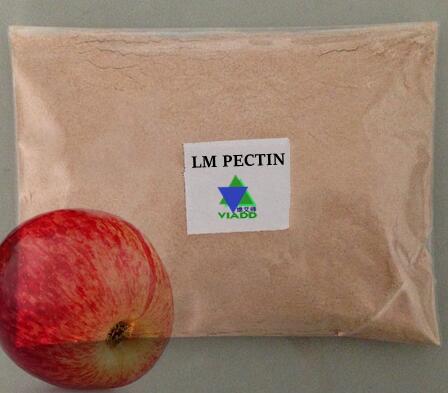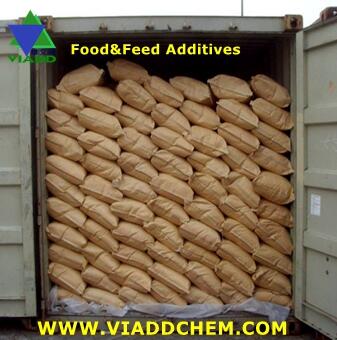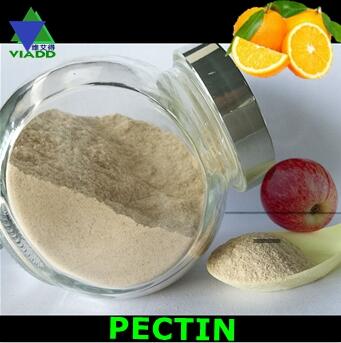


ABOUT PECTIN
VIADD CHEMICAL company is one professional PECTIN supplier, distibutor and exporter from China, welcome get PECTIN price by email: sales@viaddchem.com
Pectin is an acidic polysaccharide in plant material, it is usually white to pale yellow powder, slightly sour, with a water-soluble, widely used in food, pharmaceutical, cosmetic and textile industry. Pectin on food for jam, jelly, popsicle, ice cream, yogurt, lactic acid, fruit juice. Used in bread baking on the increase in volume and reduce the amount of flour used to extend shelf life. Pectins, also known as pectic polysaccharides, are rich in galacturonic acid.
Pectin (from Ancient Greek: πηκτικός pēktikós, "congealed, curdled" is a structural heteropolysaccharide contained in the primary cell walls of terrestrial plants. It was first isolated and described in 1825 by Henri Braconnot. It is produced commercially as a white to light brown powder, mainly extracted from citrus fruits, and is used in food as a gelling agent, particularly in jams and jellies. It is also used in dessert fillings, medicines, sweets, as a stabilizer in fruit juices and milk drinks, and as a source of dietary fiber.
Pectin on food as thickener, gelling agent, stabilizer, suspending agent, emulsifier, flavor synergists, can be used for cosmetics, to protect the skin against UV radiation, cure wound and beauty are kept a certain role.
【Basic Information】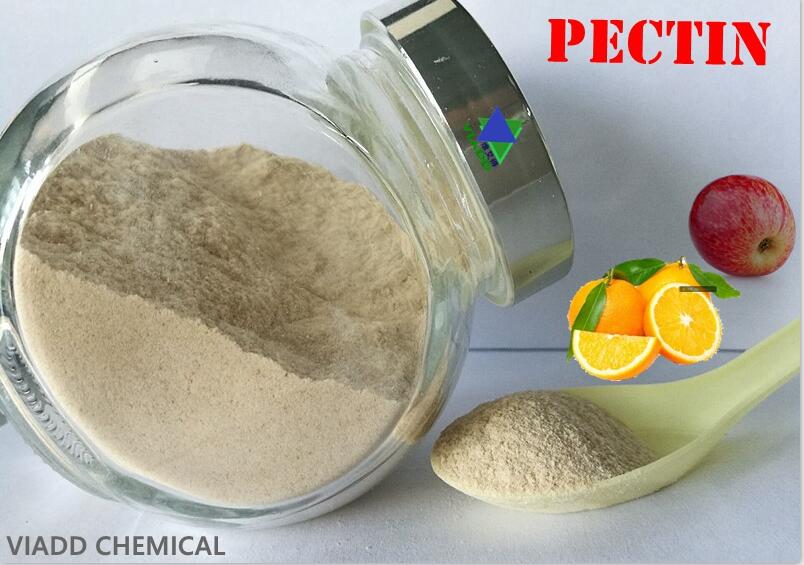
【Product Name】Pectin
【CAS No.】9000-69-5
【EINECS No.】232-553-0
【E No.】E440
【HS Code】1302200000
【Molecular Formula】C5H10O5
【Formula Weight】150.1299
【Specification】GB25533-2010 Viscosity:400-500, Pass 60 mesh
【Commercial Information】
【Packing】20kg or 25kg/bag/drum/carton box/requested
【Shelf Life】2 years
【Delivery】Within 15 days of order date
【Payment】T/T, D/P, L/C
【Origin】China
【Brand】VIADD
【Supplier】Shenyang Viadd Chemical Co.,Ltd.
【Price Email】sales@viaddchem.com
【Certificate】ISO,KOSHER,HALAL,GMP, MSDS, Material Data Sheet, Non GMO,Non Allergen
【Deliver Port】Tianjin/Qingdao
【Documents】Sales Contract, Commercial Invice, Packing List, Weight List, COA, , Cetificate of Origin, Healthey Certificate, FORM A, FORM E, Policy of Indusrance, B/L, Loading container photos, packing photos, shipping advice, etc
【Types of Pectin】
The percentage of ester groups is called degree of esterification. High methyl ester pectins are classified in groups according to their gelling temperature as rapid set to slow set pectins
We can supply HM and LM pectin, and below is the detail information:
1. High Methyl Ester (HM) Pectin: Degree of Esterification (DE) 50%~78%
2. Low Methyl Ester (LM) Pectin: Degree of Esterification (DE) 25%~50%
(1). De: >75%, HM Rapid Set
(2). De: 70-72%, HM Rapid Set
(3). De: 66-68%, HM Medium Rapid Set
(4). De: 63-65%, HM Slow Set
(5). De: 59-62%, HM Slow Set
(6). De: <50%, LM
3. Amidated LM Pectin: Degree of Esterification (DE) 20%~45%, Degree of Amidation (DA) 12%~25%
4. Pharmaceutical and Medical Pectin: Galacturonic Acid ≥ 74%
5. Apple Pectin and Citrus Pectin are all available
Within each of these main types, there are many detailed variations prepared for different uses.The structure of pectin molecules is the key to the properties of pectins, and their use in different applications.
Therefore, it is important to tell us what you will do with pectin so that we are able to recommend you a suitable type.
【Application of Pectin】
1. Food industry:
Pectin is widely used in processing of food and beverages, such as jam, jelly, fruit yogurt, soft sweets, ice cream, sour milk or fruit yogurt, soymilk. It is functions as gelantinizer, suspending agent, stabilizer, and thickening agent. A small amount of pectin can improve greatly the quality and appearing of the food. It helps giving food a natural, moderate, tart and sweet fruit taste, and charming delicate fragrance flavor.
2. Pharmaceutical industry:
Pectin is also used extensively in pharmaceutical industry. The pectin has definite curative effects on some chronic such as hypertension and constipation. It can reduce the level of blood sugar and blood fat, cut dwon cholesterol concentration, and relieve lead poisoning. And it is also used in cancer prevention and treatment.
【LM Pectin 】
1.Introduction: Low methoxyl pectin (low ester) with less than 50% of esterfication degree. Modification of the extraction process, or continued acid treatment, will yield a "low methyl ester (LM) pectin" with less than 50% methyl ester groups.

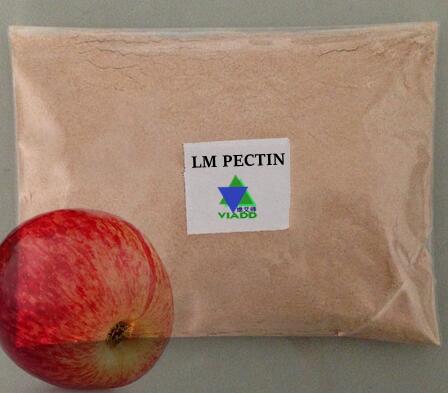
2. LM Pectin Applications:
Low Methyl Ester (LM) Pectin is used in a wide range of lower sugar products, reduced sugar preserves, fruit preparations for yoghurts, dessert gels and toppings, and savoury applications such as sauces and marinades.
Low Methyl Ester (LM) Pectin can also be used in low acid high sugar products such as preserves containing low acid fruits (figs, bananas) and confectionery.
3. LM Pectin Specifications:
|
ANALYSIS |
SPECIFICATION |
|
Appearance |
Light Brown Fine Powder |
|
Odor & Taste |
Characteristic |
|
Degree of Esterification |
25%~50% |
|
Galacturonic Acid |
≥65% |
|
Gel Strength |
≥145 |
|
Loss on Drying |
≤12% |
|
Insoluble Acid |
≤1% |
|
Sulfur Dioxide |
≤50ppm |
|
Heavy Metal |
|
|
Pb |
<3ppm |
|
As |
<2ppm |
|
Hg |
<1ppm |
|
Cd |
<1ppm |
|
Microbiology |
|
|
Total Plate Count |
<1000cfu/g |
|
Yeast & Moulds |
<100cfu/g |
|
E.Coli |
Negative |
|
Salmonella |
Negative |
【HM Pectin 】
1. Introduction: High methoxyl pectin (high ester) with more than 50% of esterfication degree, below is the formular:

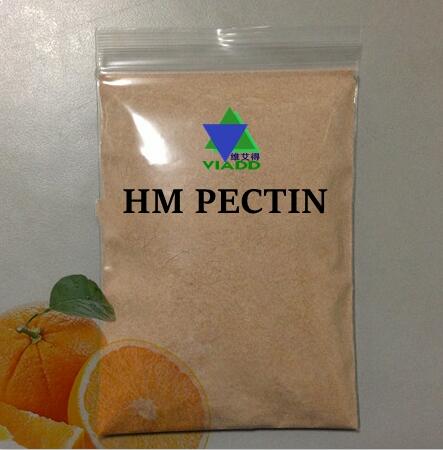
2. HM Pectin Applications:High Methyl Ester (HM) Pectin is used in a wide range of acid milk beverage and fruit juice drinks, higher sugar jams, jellies and confectionery with soluble solids>55%.High Methyl Ester (HM) Pectin can also be used in health and nutritional products.
3. HM Pectin Specifications:
|
ANALYSIS |
SPECIFICATION |
|
Appearance |
Light Brown Fine Powder |
|
Odor & Taste |
Characteristic |
|
Degree of Esterification |
50%~78% |
|
Galacturonic Acid |
≥65% |
|
Gel Strength |
≥145 |
|
Loss on Drying |
≤12% |
|
Insoluble Acid |
≤1% |
|
Sulfur Dioxide |
≤50ppm |
|
Heavy Metal |
|
|
Pb |
<3ppm |
|
As |
<2ppm |
|
Hg |
<1ppm |
|
Cd |
<1ppm |
|
Microbiology |
|
|
Total Plate Count |
<1000cfu/g |
|
Yeast & Moulds |
<100cfu/g |
|
E.Coli |
Negative |
|
Salmonella |
Negative |
【History of Pectin】
1. Pectin was first isolated and described in 1825 by Henri Braconnot, though the action of pectin to make jams and marmalades was known long before. To obtain well set jams from fruits that had little or only poor quality pectin, pectin-rich fruits or their extracts were mixed into the recipe.
2. During the Industrial Revolution, the makers of fruit preserves turned to producers of apple juice to obtain dried apple pomace that was cooked to extract pectin.
3. Later, in the 1920s and 1930s, factories were built that commercially extracted pectin from dried apple pomace and later citrus-peel in regions that produced apple juice in both the USA and in Europe.
4. Pectin was first sold as a liquid extract, but is now most often used as dried powder, which is easier than a liquid to store and handle.
【Sources and Production】
The main raw materials for pectin production are dried citrus peel or apple pomace, both by-products of juice production. Pomace from sugar beet is also used to a small extent.
Pears, apples, guavas, quince, plums, gooseberries, and oranges and other citrus fruits contain large amounts of pectin, while soft fruits like cherries, grapes, and strawberries contain small amounts of pectin.
Typical levels of pectin in plants are (fresh weight):
apples, 1–1.5%, apricots, 1%, cherries, 0.4%, oranges, 0.5–3.5%, carrots approx. 1.4%, citrus peels, 30%
From these materials, pectin is extracted by adding hot dilute acid at pH-values from 1.5 – 3.5. During several hours of extraction, the protopectin loses some of its branching and chain length and goes into solution. After filtering, the extract is concentrated in vacuum and the pectin then precipitated by adding ethanol or isopropanol. An old technique of precipitating pectin with aluminium salts is no longer used (apart from alcohols and polyvalent cations, pectin also precipitates with proteins and detergents).
Alcohol-precipitated pectin is then separated, washed and dried. Treating the initial pectin with dilute acid leads to low-esterified pectins. When this process includes ammonium hydroxide, amidated pectins are obtained. After drying and milling, pectin is usually standardised[clarification needed] with sugar and sometimes calcium salts or organic acids to have optimum performance in a particular application.




